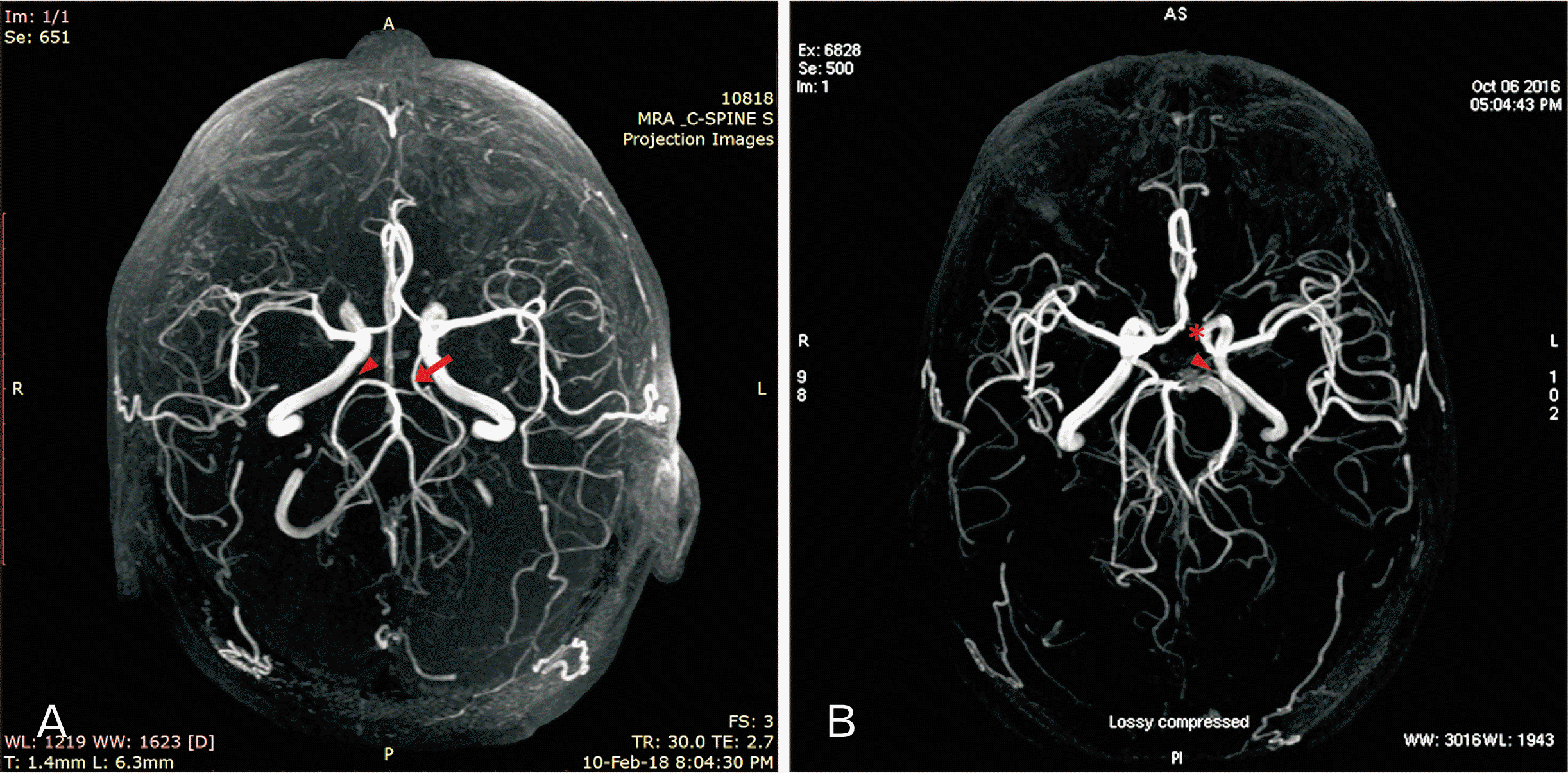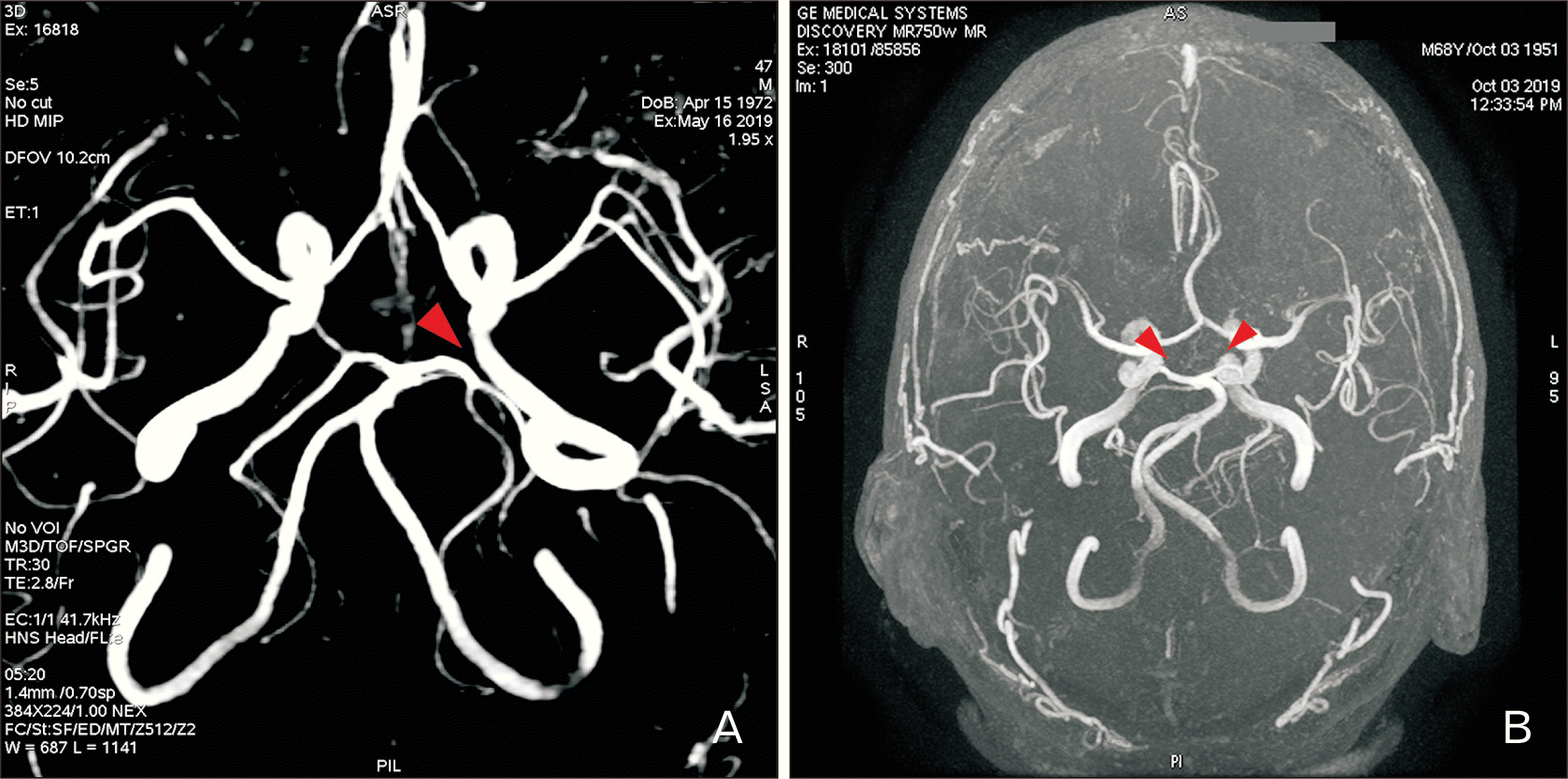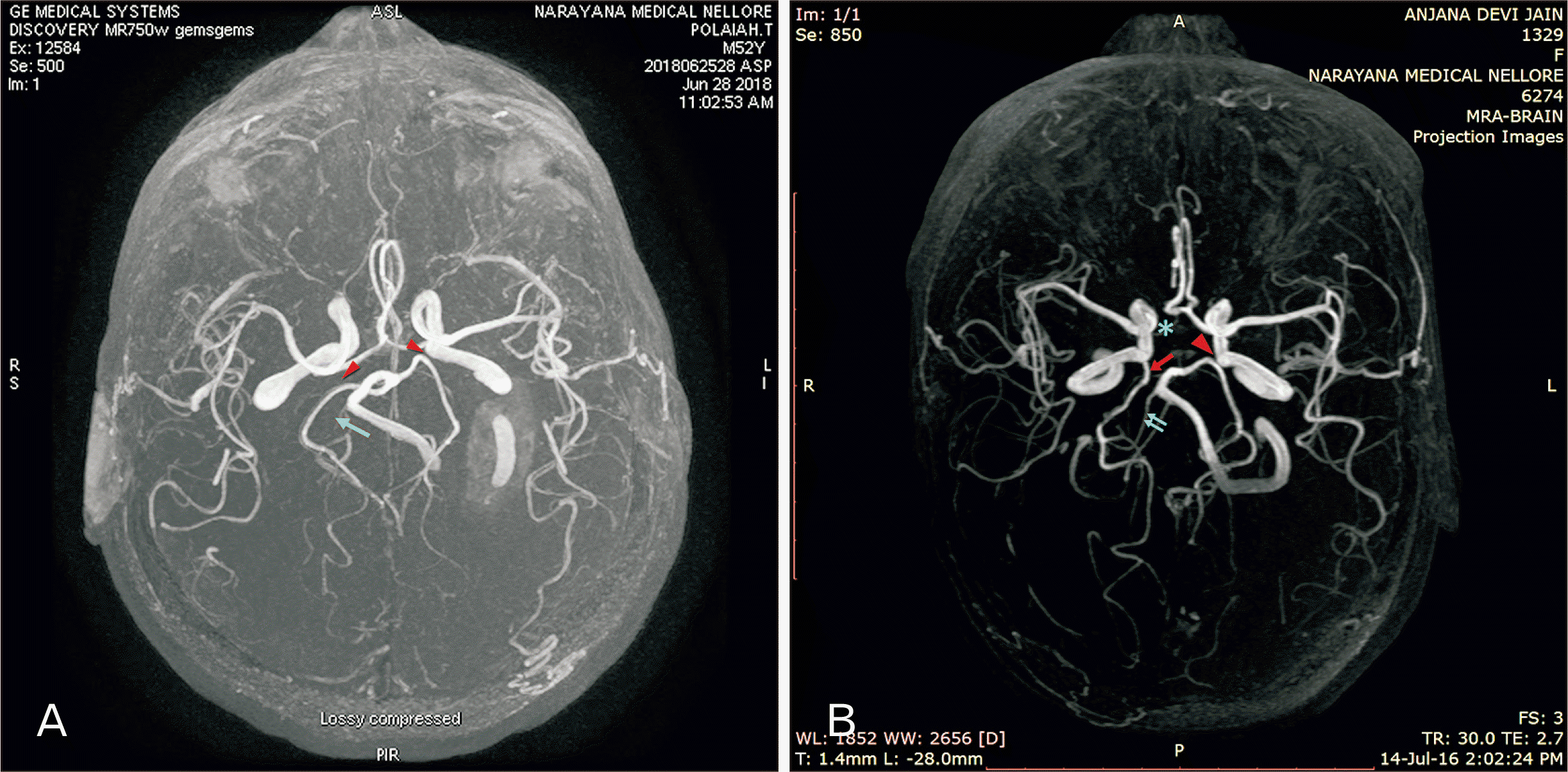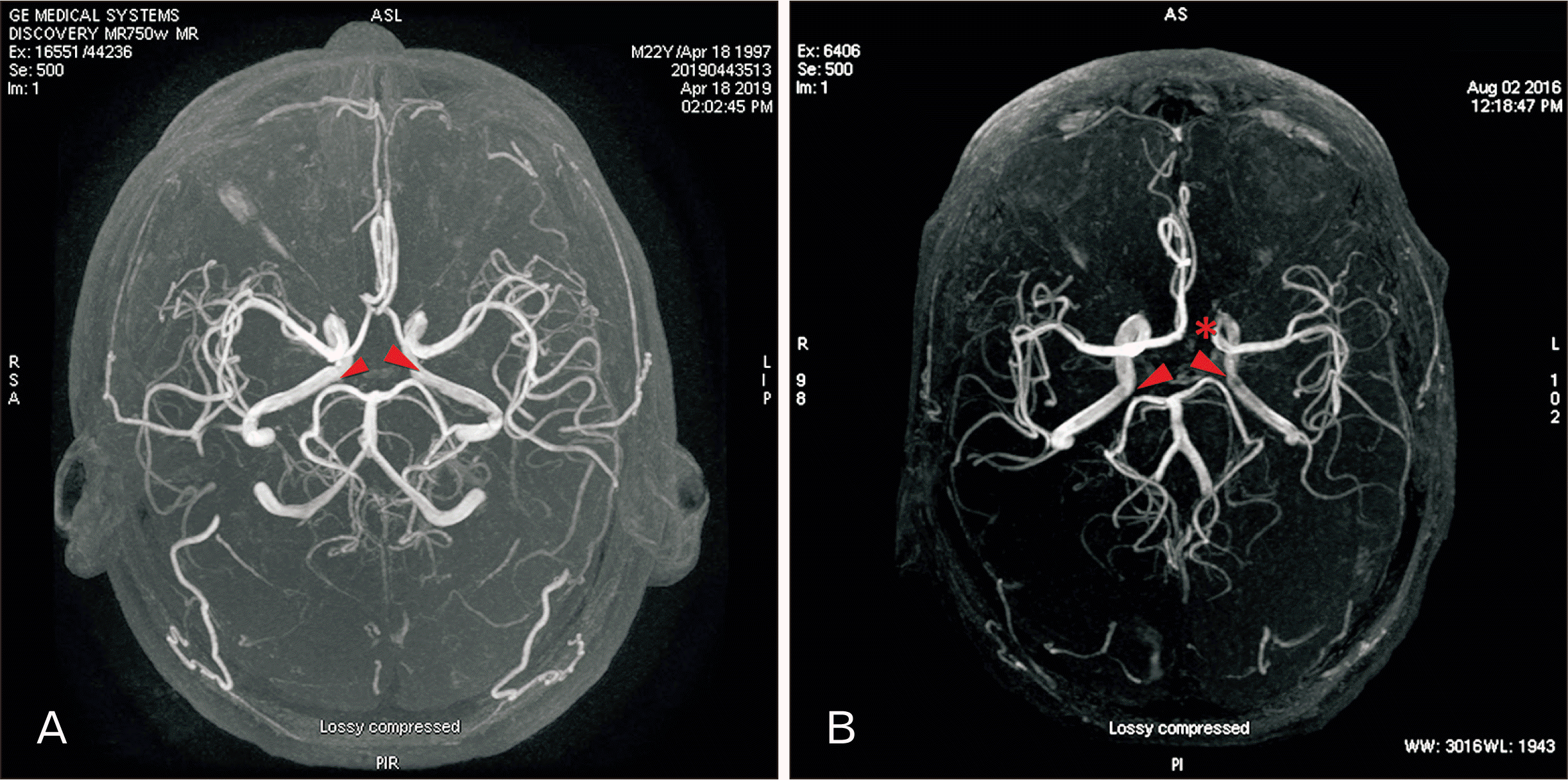1. Eftekhar B, Dadmehr M, Ansari S, Ghodsi M, Nazparvar B, Ketabchi E. 2006; Are the distributions of variations of circle of Willis different in different populations? - Results of an anatomical study and review of literature. BMC Neurol. 6:22. DOI:
10.1186/1471-2377-6-22. PMID:
16796761. PMCID:
PMC3680999.

3. Roopashree R. 2013; A anatomical study on relationship between posterior cerebral artery and posterior communicating artery. Int J Anat Radiol Surg. 2:9–12.
4. Krabbe-Hartkamp MJ, van der Grond J, de Leeuw FE, de Groot JC, Algra A, Hillen B, Breteler MM, Mali WP. 1998; Circle of Willis: morphologic variation on three-dimensional time-of-flight MR angiograms. Radiology. 207:103–11. DOI:
10.1148/radiology.207.1.9530305. PMID:
9530305. PMCID:
PMC4683875.

5. Feldman BA. 2013; Embryology and variations of cerebral arteries- a pictorial review. European Soc Radiol. 1–33. doi: 10.1594/ecr2013/C-2520.
6. Chuang YM, Liu CY, Pan PJ, Lin CP. 2008; Posterior communicating artery hypoplasia as a risk factor for acute ischemic stroke in the absence of carotid artery occlusion. J Clin Neurosci. 15:1376. DOI:
10.1016/j.jocn.2008.02.002. PMID:
18945618.

7. Pentyala S, Sankar KD, Bhanu PS, Kumar NSS. 2019; Magnetic resonance angiography of hypoplastic A1 segment of anterior cerebral artery at 3.0-Tesla in Andhra Pradesh population of India. Anat Cell Biol. 52:43. DOI:
10.5115/acb.2019.52.1.43. PMID:
30984451.

9. Conijn MM, Hendrikse J, Zwanenburg JJ, Takahara T, Geerlings MI, Mali WP, Luijten PR. 2009; Perforating arteries originating from the posterior communicating artery: a 7.0-Tesla MRI study. Eur Radiol. 19:2986–92. DOI:
10.1007/s00330-009-1485-4. PMID:
19533146. PMCID:
PMC2778782.

10. Zwanenburg JJ, Hendrikse J, Takahara T, Visser F, Luijten PR. 2008; MR angiography of the cerebral perforating arteries with magnetization prepared anatomical reference at 7 T: comparison with time-of-flight. J Magn Reson Imaging. 28:1519. DOI:
10.1002/jmri.21591. PMID:
19025959.
11. Ardakani SK, Dadmehr M, Nejat F, Ansari S, Eftekhar B, Tajik P, El Khashab M, Yazdani S, Ghodsi M, Mahjoub F, Monajemzadeh M, Nazparvar B, Abdi-Rad A. 2008; The cerebral arterial circle (circulus arteriosus cerebri): an anatomical study in fetus and infant samples. Pediatr Neurosurg. 44:388–92. DOI:
10.1159/000149906. PMID:
18703885.
12. Neau JP, Bogousslavsky J. 1996; The syndrome of posterior choroidal artery territory infarction. Ann Neurol. 39:779. DOI:
10.1002/ana.410390614. PMID:
8651650.
13. Wardlaw JM, Dennis MS, Warlow CP, Sandercock PA. 2001; Imaging appearance of the symptomatic perforating artery in patients with lacunar infarction: occlusion or other vascular pathology? Ann Neurol. 50:208. DOI:
10.1002/ana.1082. PMID:
11506404.

14. Chuang YM, Huang YC, Hu HH, Yang CY. 2006; Toward a further elucidation: role of vertebral artery hypoplasia in acute ischemic stroke. Eur Neurol. 55:193. DOI:
10.1159/000093868. PMID:
16772715.

15. Fischer U, Arnold M, Nedeltchev K, Brekenfeld C, Ballinari P, Remonda L, Schroth G, Mattle HP. 2005; NIHSS score and arteriographic findings in acute ischemic stroke. Stroke. 36:2121–5. DOI:
10.1161/01.STR.0000182099.04994.fc. PMID:
16151026.

16. Vilimas A, Barkauskas E, Vilionskis A, Rudzinskaite J, Morkunaite R. 2003; Vertebral artery hypoplasia: importance for stroke development, the role of posterior communicating artery, possibility for surgical and conservative treatment. Acta Med Litu. 10:110–4.
17. Park JH, Kim JM, Roh JK. 2007; Hypoplastic vertebral artery: frequency and associations with ischaemic stroke territory. J Neurol Neurosurg Psychiatry. 78:954. DOI:
10.1136/jnnp.2006.105767. PMID:
17098838. PMCID:
PMC2117863.

18. De Silva KR, Silva R, De Silva C, Gunasekera WS, Dias P, Jayesekera RW. 2010; Comparison of the configuration of the posterior bifurcation of the posterior communicating artery between fetal and adult brains: a study of a Sri Lankan population. Ann Indian Acad Neurol. 13:198. DOI:
10.4103/0972-2327.70886. PMID:
21085531. PMCID:
PMC2981758.

19. Sahni D, Jit I, Lal V. 2007; Variations and anomalies of the posterior communicating artery in Northwest Indian brains. Surg Neurol. 68:449. DOI:
10.1016/j.surneu.2006.11.047. PMID:
17905073.

20. Krishnamurthy A, Nayak SR, Ganesh Kumar C, Jetti R, Prabhu LV, Ranade AV, Rai R. 2008; Morphometry of posterior cerebral artery: embryological and clinical significance. Rom J Morphol Embryol. 49:43–5. PMID:
18273501.
22. Caldemeyer KS, Carrico JB, Mathews VP. 1998; The radiology and embryology of anomalous arteries of the head and neck. AJR Am J Roentgenol. 170:197. DOI:
10.2214/ajr.170.1.9423632. PMID:
9423632.

23. Abrahams JM, Hurst RW, Bagley LJ, Zager EL. 1999; Anterior choroidal artery supply to the posterior cerebral artery distribution: embryological basis and clinical implications. Neurosurgery. 44:1308. DOI:
10.1227/00006123-199906000-00083. PMID:
10371631.

24. Lasjaunias P, Berenstein A, ter Brugge KG. Lasjaunias P, Berenstein A, ter Brugge KG, editors. 2001. Intradural Arteries. Clinical vascular anatomy and variations. 2nd ed. Springer;Berlin: p. 479–629. DOI:
10.1007/978-3-662-10172-8_6.

25. Jayaraman MV, Mayo-Smith WW. 2004; Multi-detector CT angiography of the intra-cranial circulation: normal anatomy and pathology with angiographic correlation. Clin Radiol. 59:690. DOI:
10.1016/j.crad.2003.12.004. PMID:
15262542.

26. Padge DH. 1948; The development of the cranial arteries in the human embryo. Contrib Embryol. 32:205–61.
27. Parmar H, Sitoh YY, Hui F. 2005; Normal variants of the intracranial circulation demonstrated by MR angiography at 3T. Eur J Radiol. 56:220. DOI:
10.1016/j.ejrad.2005.05.005. PMID:
15950421.

28. Hoksbergen AW, Fülesdi B, Legemate DA, Csiba L. 2000; Collateral configuration of the circle of Willis: transcranial color-coded duplex ultrasonography and comparison with postmortem anatomy. Stroke. 31:1346. DOI:
10.1161/01.STR.31.6.1346. PMID:
10835455.
29. Al-Hussain SM, Shoter AM, Bataina ZM. 2001; Circle of Willis in adults. Saudi Med J. 22:895.
30. Zhou W, Lu M, Li J, Chen F, Hu Q, Yang S. 2019; Functional posterior communicating artery of patients with posterior circulation ischemia using phase contrast magnetic resonance angiography. Exp Ther Med. 17:337. DOI:
10.3892/etm.2018.6897. PMID:
30651800. PMCID:
PMC6307428.

31. Gunnal SA, Farooqui MS, Wabale RN. 2015; Study of posterior cerebral artery in human cadaveric brain. Anat Res Int. 2015:681903. DOI:
10.1155/2015/681903. PMID:
26413321. PMCID:
PMC4561305.

32. Tuncer MC, Akgül YH, Karabulut Ö. 2010; MR angiography imaging of absence vertebral artery causing of pulsatile tinnitus: a case report. Int J Morphol. 28:357–63. DOI:
10.4067/S0717-95022010000200003.

33. Vasuki AKM, Devi MN, Jamuna M. 2015; Absent intracranial part of right vertebral artery-a case report. Innov J Med Health Sci. 5:6–8.
34. Kang DW, Chu K, Ko SB, Kwon SJ, Yoon BW, Roh JK. 2002; Lesion patterns and mechanism of ischemia in internal carotid artery disease: a diffusion-weighted imaging study. Arch Neurol. 59:1577. DOI:
10.1001/archneur.59.10.1577. PMID:
12374495.








 PDF
PDF Citation
Citation Print
Print



 XML Download
XML Download